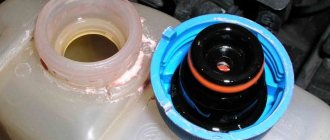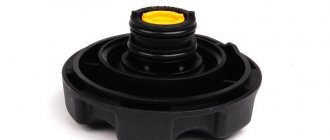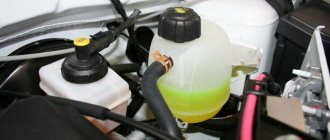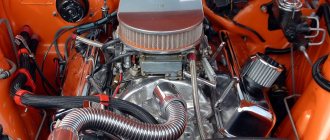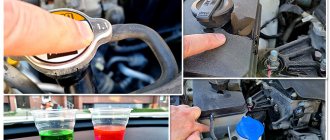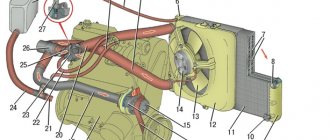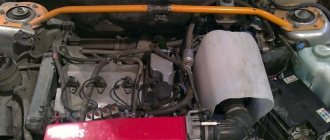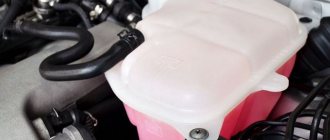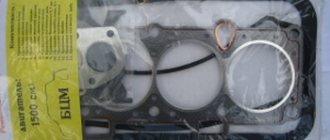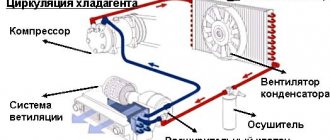You can use a pump with a pressure gauge to check the cover. Having removed the thinnest, upper pipe from the tank, you need to attach a pump to the tank and start supplying air. The exhaust valve should be triggered by a pressure of no more than 1.5 kilograms per square centimeter, or in other words 1.5 atmospheres. If the valve does not operate, the cap must be replaced. Through such simple manipulations, you can determine the serviceability of the expansion tank cap and eliminate the malfunction in time, which will protect the car engine from serious damage.
What is an expansion tank cap
Any driver, even the most inexperienced, knows well why an expansion tank is needed in a car.
Coolant is poured into it, and the remaining free volume is designed to compensate for the increase or decrease in the amount of expanded liquid. Accordingly, the tank is closed with a lid. The cover is installed on the tank neck in the upper part. Many drivers do not attach much importance to the lid - after all, it is important to simply maintain the tightness of the tank, and what exactly to close it with does not matter.
Yes, the expansion tank cap is a locking element. However, contrary to popular belief, the lid has a complex structure and performs special functions.
The cover cavity includes a rubber seal and a double valve mechanism
What does the element consist of?
The lid has two valves. They are designed to protect the cooling system from possible damage due to overheating, in addition, these valves stabilize the operation of the entire system.
If you unscrew the cap from the tank and look at its internal structure, you can see a kind of pressure regulation sensor.
Two valves are plugs of two closing springs
The lid must fit tightly (without gaps) to the edges of the tank. To ensure a reliable connection, the lid includes a rubber seal. There are two valves built inside:
- the first relieves excess pressure in the tank;
- the second pumps the necessary pressure into the tank if the pump for some reason does not cope with its job.
These valves got their names due to the use of high or low pressure: on VAZs the first valve is called a safety valve, and the second is called a vacuum valve. However, both are at rest as long as the pressure in the tank is within the specified reading range.
The valve mechanisms of the lids on VAZs are springs
The driver cannot always notice malfunctions in the operation of the cover valves in time. It is simply impossible to make a visual diagnosis. But failure of parts of the expansion tank cap can lead to serious problems with the engine unit.
Symptoms of a faulty expansion tank cap
Owners of Russian-made cars know how important it is to monitor the condition of all systems in the car’s design. Even such a small element as the expansion tank cap can cause a lot of trouble - for example, if the valve mechanisms fail, the operation of the entire cooling system can be disrupted. As a result, the engine overheats and the cylinders jam. In this case, the driver will face expensive repairs.
We recommend: What are the markings for xenon and halogen headlights?
Therefore, in order to prevent unpleasant consequences, you need to carefully monitor some features in the car’s behavior while driving:
- Puffs of smoke appear from under the hood - therefore, coolant has hit the hot surface of the intake manifold. Antifreeze could get onto the manifold for only one reason - the safety valve on the cover had failed;
- Cool air comes out of the stove, and the engine gets very hot: this is a sign of failure of the vacuum valve of the cover. Due to malfunctions in its operation, air plugs occur in the cooling system, which leads to overheating of the engine;
- failures of clamps and ruptures of hoses also indicate that the pressure in the system is unstable. And since it is the expansion tank cap that is responsible for the pressure, these symptoms indicate that it is time to replace or repair it.
If plumes of smoke are escaping from under the hood, this may indicate a faulty expansion tank cap.
How to determine if there is a problem: symptoms, signs, diagnosis
Diagnostics are designed to help find the cause of malfunctioning cooling system. If antifreeze constantly disappears somewhere, boils, boils strongly in the cooling radiator, and the interior does not heat up, all this needs to be dealt with. If the antifreeze level regularly drops, air will take its place, which over time will form an air lock.
In this case, you need to check the tightness of all connections of the engine cooling system. To do this, carry out a careful external inspection of the interfaces of rubber parts (hoses, pipes) with tubes and fittings with a warm, running engine. Pay special attention to the radiator pipes, water pump, thermostat and heater hoses. If a leak is detected, it must be eliminated by replacing the pipes or tightening the steel clamps.
New Lada: Immobilizer on LADA KALINA: how to disable, activate or remove the fault with your own hands, where the VAZ unit is located and how it works, photos and videos
The main burden of adjusting (while the engine is warming up) and maintaining a constant (while the engine is running) temperature in the cooling system falls on the thermostat. If the engine begins to warm up very quickly after starting, the electric fan starts almost simultaneously, and the arrow on the indicator tends to move into the red zone - these signs indicate a malfunction of the thermostat or an accumulation of air in the discharge pipe from the pump. The thermostat valve will be closed all the time, and the antifreeze will circulate only in a small circle.
Air accumulation in the thermostat: process diagram
But if the engine takes a long time to warm up, and the needle is frozen at the beginning of the scale, this is a sign of a constantly open valve at the thermostat or the formation of an air lock in the thermostat itself. An open valve cannot switch the antifreeze circulation to a small circle to quickly warm up the engine.
To check that the thermostat is working correctly, you need to start the engine and let it run until the temperature gauge needle starts moving. We touch the cooling radiator pipes with our hands. The top one should be warm and the bottom one should remain cold. As the engine continues to operate, the pipe at the top of the radiator should become increasingly hotter, and the lower pipe should remain the same cold.
The technical condition of the water pump can be judged by its operating noise; absence of antifreeze leakage through the oil seal; absence of vibrations due to wear of the bearing on the pump shaft. Leakage of antifreeze indicates air leakage and the formation of air accumulations in the cooling system.
To summarize: outside air can enter a closed engine cooling system in three cases:
- in case of inept filling of antifreeze into the system when replacing it and adding it to the norm;
- in case of partial depressurization of the system and air leaks through loose connections;
- if the air valve of the expansion tank breaks down.
Since air is much lighter than coolant, it will always tend to rise. Therefore, the methods for removing air accumulations from the cooling system are the same for all types of internal combustion engines (diesel, carburetor, longitudinal or transverse, V-shaped or in-line, etc.).
The surest sign of air accumulation in the cooling system is poor heat supply by the stove when the engine is normally warmed up.
Cover device
It is important to understand that there is a locking element for expansion tanks on any car that has an internal combustion engine under the hood. And it doesn’t matter whether it’s diesel, gasoline or gas-powered.
Therefore, the problem with the failure of this unit can occur on any car, including such models as:
- Lada Kalina;
- Ford Focus;
- Gazelle Next;
- Daewoo Lanos;
- Volkswagen Passat;
- Lada Priora;
- VAZ 2110;
- Renault Logan;
- Opel Astra;
- VAZ 2114;
- Chevrolet Lacetti, etc.
You already understand that the cap serves not only to prevent coolant from pouring out of the tank. This is also a pressure regulator in the system.
A valve is hidden inside the lid, usually made of plastic. It is he who takes on such responsibility. The valve is immersed inside the expansion tank and, as necessary, pumps or releases excess pressure.
Before buying a new element, if you suspect the old one is broken, you can check it. A similar type of locking mechanism should be selected.
Please note that all modern foreign cars, in the vast majority of cases, have switched to single-valve caps for expansion tanks. That is, only one valve design is physically present. It just can perform two functions at once. While on domestic cars you can still find a pair of valves. Each of them is responsible for performing a corresponding function. Whether this is good or bad is difficult to judge. But the fact remains a fact.
The lid is activated only when an excess or deficit of pressure is detected in the system. Each car has its own temperature and pressure standards for the element to operate.
Classic lid upgrade method
Upgrading the cover in this embodiment involves removing and disassembling the component. We take out the rubber seal and the internal assembly (a pair of springs with a valve). We use a screwdriver.
Refinement involves trimming two springs. The first of them must be shortened by one turn, and the second by as many as two. We assemble according to a well-known algorithm. After this, we check the functionality of the upgraded node. The valve outlet element will now begin to open when the pressure reaches 1 bar. Previously, this figure was 1.7 bar.
Upon successful completion, the lid can be easily blown through the mouth. This check ensures there is free passage of air in both directions. If the indicated effect is observed, then we can state that the modification is correct. Now the risk of airing the circuit has been reduced many times over.
How everything works
The main task of the sealing device on the expansion tank is to maintain a certain pressure for the system. In this case, the threaded connection must ensure a high contact density of the surfaces after screwing.
The expansion tank cap design assumes the presence of a built-in valve that ensures voltage balance. Depending on the current situation, one of the tasks is performed:
- the process of releasing excess volume into the atmosphere occurs;
- volume is pumped to get rid of the vacuum inside;
- the valve is in the closed position, without interaction with the surrounding space.
It must be taken into account that in old domestic cars two independent valves are responsible for pumping and releasing pressure. In modern machines, one valve is used for both operations.
A few tips for maintaining a healthy system
You can avoid most problems, from minor troubles to serious damage associated with the expansion tank cap, if you follow a few rules. Professionals advise the following:
- Change the expansion tank cap at least once every 2-3 years. Aggressive coolant components attack mechanism parts and seals, gradually destroying them.
- Use only the original cover to replace a worn one. Some analogues do not allow the engine to operate at the required temperatures.
- Check and adjust the valves only on a cold engine, otherwise you risk getting burned from boiling water splashing out under pressure.
- Use tuned expansion tank caps only temporarily. Such a part will not provide optimal engine performance parameters and is therefore poorly suited for installation on a car.
In most cases, to restore the functionality of the mechanism, it is enough to simply clean the valves and rubber seals from dirt and sediment. If this procedure does not help, then it is easier to buy a new one, since modern expansion tank caps are made non-removable.
What is an expansion tank cap
To tell the truth, few drivers pay much attention to such a part of their car as the cap on the expansion tank. 90% of car owners believe that the cover acts as a locking device, that is, it simply prevents the coolant from splashing while driving . However, this is the opinion of amateurs.
We recommend: What does your car smell like? We determine the malfunction by smell
The tank cap is indeed a locking device, but this is not its only function. Inside the cover there are two valves that stabilize the pressure in the cooling system and protect the engine from exposure to high temperatures.
The lid fits tightly to the edge of the tank, thereby creating conditions for complete sealing of the cooling system
Device and functions
So, the lid contains the following elements:
- body made of hard plastic alloys;
- rubberized gasket that acts as a seal;
- two valves, one of which lowers the high pressure in the system, and the other raises it if necessary.
The covers of different car models may include from one to three springs
In essence, the expansion tank cap is a pressure regulation sensor. After all, when the engine warms up, the temperature of the coolant also increases, and therefore its volume increases. The more the antifreeze or antifreeze warms up, the higher the pressure in the cooling system. At peak temperatures, the amount of coolant can increase due to expansion by 20%! Of course, under such loads, both the tank itself and the fittings leading to it can rupture. To prevent this from happening, a safety valve is built into the tank lid, which gradually releases excess pressure.
The second valve is called a vacuum valve, since its main task is to increase the pressure in the system. It works mainly in the winter season, when the car is parked overnight in open areas. During parking, the coolant quickly cools down and begins to decrease in volume. Accordingly, the pressure in the system quickly drops. When the driver starts the engine, antifreeze cannot cool it properly. To stabilize the coolant pressure, a vacuum valve mechanism is installed in the reservoir cap.
If the cap loses its seal, it may fly out of the tank neck under the influence of high pressure.
That is, the expansion tank cap on cars works “in both directions” - it can both lower and increase pressure. Despite its apparent simplicity, the cover performs a job of primary importance and, one might say, protects the hoses and radiator from damage.
Tuesday, March 26, 2013
How to remove an airlock on Kalina
3. Failure of the cylinder head gasket (leakage from under the cylinder head, bubbling in the cylinder head, antifreeze in the oil crankcase - emulsion formation, abundant white steam in the exhaust). Low efficiency of the SOD, manifested in overheating, bubbling and poor heating of the interior, can be a consequence not only of a plug, but also a decrease in pump performance (breakage, deformation, rotation of the impeller on the shaft), kinks and contamination of the SOD. Incorrect operation of the thermostat (not fully opening) can also lead to difficulties when removing the plug. Only after thoroughly checking the ODS for the absence of these breakdowns should you start talking about the airlock and how to remove it. A traffic jam can form in a small or large circle. The plug is removed through the highest point of the system. Previously, in cars without an expansion tank, its functions were performed by the radiator. Therefore, there was a way to raise the front of the car so that the top of the radiator became the highest point and let the engine run. In our case, this is not very effective, because in a closed system, the plug can only exit into the expansion tank. There are no other places, but they can be created by disconnecting the system. Please note that the expansion tank in Kalina is included in a large circle, and without opening the thermostat, there is no way to remove the plug from the small circle in the Republic of Belarus. The coolant simply won't flow there. And now it’s clear why problems often arise in cold weather. It’s just that in cold weather the thermostat practically does not open, but completely, and therefore the release of the plug into the tank is very problematic. Now it becomes clear why gassing helps. It simply leads to faster heating and the opening of a large circle, which ensures the release of the plug, because the tank is installed in a large circle. But the car must be heated until the fan operates, i.e. up to 101-105 degrees, it is only at this temperature that the thermostat will fully open. That is. The condition for the plug to exit through the RB is the COMPLETE opening of the thermostat, and in winter, and even while driving, this is difficult to achieve. That's why she sits there tightly.
In order to remove the traffic jam
We must open the thermostat completely, for which we need to warm up the car until the fan comes on. To be sure, you can also squeeze the radiator inlet and outlet pipes. Is it necessary to lift your muzzle, the answer is no, rather you need to raise your left side, where the RB is located. Is it necessary to accelerate, most likely yes, but not with all the might, it’s just not realistic to warm up the car at idle in cold weather until the fan comes on. Those. the same effect can be obtained with a stationary car at medium speed. But keep in mind that this method can only help if the thermostat is in working order and opens completely (at least 8 mm opening), otherwise if it is not fully opened, if the plug is in a small circle and the coolant circulation is disrupted, by accelerating too much you can overheat the engine, with all the ensuing consequences. Please note that fanaticism in repairing SOD can end badly. Unfortunately, you can only check how the thermostat opens by removing it and boiling it in a pan of water. I would like to note that when filling coolant, it is better to always remove the pipe from the remote control, because Kalina's SOD is designed so that the system is filled from the bottom up. This way you are guaranteed not to get a traffic jam, but even here you should warm up the engine by turning on the fan, monitoring the coolant level in the coolant compartment and topping up if necessary. Stove. The stove is located relatively low and a plug can form there, which, provided there is a small difference in pressure at the inlet and outlet of the stove, is poorly expelled. Here it is better not to be lazy and if there is a problem, disconnect one hose going to the stove, pumping coolant through it. This will definitely eliminate any air that gets trapped there. Don’t feel sorry for spilled antifreeze when removing plugs in the SOD; this is a much smaller loss than what you can get.
Consequences of a broken tank cap
Many drivers very rarely pay attention to the tank cap, and do not even suspect what an important role it plays in the entire cooling system. Many people do not open this lid for years, and it begins to sour. The valves stop working correctly, and at one point, due to a lack of tightness in the cooling system, air pockets form.
The car begins to boil and the interior heater stops working. An overheated engine fails and can be quite expensive to repair. It also happens that the exhaust valve jams, and then excess pressure forms in the cooling system, which can rupture the pipes, cooling radiator, heater radiator, or make its way into the engine crankcase through the cylinder head gasket.
And this is not counting the smaller engine parts, such as the pump, thermostat. Eliminating the consequences is very expensive. All these malfunctions occurred simply due to the breakdown of such a seemingly insignificant part as the expansion tank cap.
Bought a new cover and it doesn't work?
If checking the new expansion tank cap shows that one or both valves are faulty, you can try to modify the part. Owners of VAZ 2110 and 2114 cars often encounter this problem. Usually the valves do not work correctly due to the manufacturer using too stiff springs.
First you need to disassemble the cover using a flathead screwdriver and pliers. During disassembly, remember exactly how all the components were installed, since the springs may fly apart in different directions. After disassembly, it is necessary to reduce the length of the springs. The large spring for the pressure relief valve is shortened by one turn, and the smaller one by two.
The safety valve spring (large) must be shortened taking into account exactly when the valve was triggered during the check of the cover. The main thing in this matter is not to overdo it. But with the second spring everything is much simpler - it should create at least minimal pressure on the intake valve at the moment of its closing. After finishing the cover, all components must be assembled in reverse order. The plug check must be repeated to ensure that the valves operate in a timely manner.
The cap of the expansion tank of a car's engine cooling system, as a rule, does not raise suspicions about its serviceability. This, as many people think, very “modest” in importance part is entrusted with a very important task - to regulate the pressure in the cooling system. When the lid stops coping with this, in the best case, liquid will boil or leak out, and in the worst case, this will lead to the breakdown of some components.
How to check the cover yourself on Priora, Grant, Kalina
It seems that it is enough to unscrew the cap from the expansion tank and inspect its insides to understand the specifics of the problem. However, it is not. For example, service centers use special pressure pumps that can pump the required number of atmospheres . By creating artificial pressure in the cooling system, the device allows you to calculate the correct operation of the valves.
A device for diagnosing VAZ tank caps has a pressure gauge and a pump
But drivers don't have this expensive equipment, so they have to make do with what they have in a standard garage. Diagnostics of the quality of operation of the tank cap will be less accurate, but it will be possible to identify the main malfunctions of the valves:
- Turn off the engine.
- Unscrew the cap from the tank neck.
- Inspect the product for cracks, dents, and chips. The seal may have ruptured or become severely worn.
- If there is no visible damage, screw the cover back on and start the engine.
- Wait until the engine warms up to its normal temperature.
- Start slowly unscrewing the cap from the tank.
- If, during the process of unscrewing, a whistle of escaping air is heard (this sound can be compared to the release of gases when opening lemonade), then the lid is in working order, since it restrains the pressure in the tank and hoses.
- After this, you need to turn off the engine again.
- Inspect the cooling system pipes. If they are pulled in, the vacuum valve of the lid does not work well, since the pressure in the system is extremely low.
We recommend: How to set the ignition using a strobe?
The expansion tank cap can only be unscrewed after the engine has cooled down. The working cap should not have expansions, cracks or dents. All pipes must have an equal diameter throughout their entire length, without thickening or shrinking. This is interesting: Preliminary diagnostics
This is a typical scheme for checking expansion tank cap valves on all models of AvtoVAZ vehicles.
Refinement of a new part - what to do if it does not function?
When it turns out that the lid stubbornly refuses to relieve excess pressure and/or is not able to restore air losses in the SOD, it can be modified. For some reason, the most complaints come from owners of VAZ, model 2109, including those who buy new plugs. It is clear that the reason for the incorrect operation of the cover valves lies in the too much rigidity of their springs.
To modify the cover, for example, for a VAZ 2109, it must first be disassembled. This must be done carefully, using pliers and a thin flat-blade screwdriver. We must try to remember where everything stood so that the springs do not fly away to God knows where. After the lid for the VAZ 2109 tank has been disassembled, it’s time for the wire cutters. They need to shorten the springs: the large one, for the safety valve, usually by 1 turn, and the small one by 2.
Shortening the plug spring
For the second, the length of the removed segment is not critical - as long as it generally supports the vacuum valve when it is closed and does not resist the external air pressure of 0.03–0.1 kgf/cm 2 . With a large spring it is more difficult - as if not to overdo it. You need to look at its rigidity and the pressure at which the safety valve opened when checking the tank cap of the VAZ 2109. After shortening the springs, we assemble the cap in the reverse order. Before use, it is advisable to check again how it works.
Signs of trouble
Before checking the cover, you need to receive a signal that it has potentially failed and is no longer performing its functions.
The symptoms of a breakdown are rather indirect and can manifest themselves in the following form:
- Thick white smoke is pouring out from under the hood;
- the engine overheats, but the stove remains cold;
- breaks the clamps;
- breaks the cooling system pipes;
- the radiator seal is broken;
- ruptures the coolant reservoir;
- the tubes are compressed and do not allow coolant to pass through;
- the circulation of antifreeze through the system is disrupted, etc.
Smoke usually appears when the pressure exceeds the permissible values. But overheating with a cold heater indicates precisely a lack of pressure in the system. Here it will be useful to remind you of the material devoted to eliminating an airlock. I'll leave a link to it. Go ahead and read.
Verification methods
Before checking the expansion tank plug, you need to know that car repair shops use special pressure pumps for this operation. They are configured in such a way as to bring the test to critical response values. Then it will be clear whether the opening or closing occurred at the right time.
Self-testing does not always provide objective evidence. However, when it is carried out, in most cases it is possible to identify the loss of unit functionality.
Performance monitoring is carried out as follows:
- With the engine cool, remove the cover and inspect it to identify chips, cracks or holes. All seals must be plastic and provide a tight seal. There should be no mechanical damage.
- Even if some minor damage is detected, we return everything to its place, tighten it tightly and start the engine.
- We wait for the internal combustion engine to warm up for several minutes and carefully begin to unscrew the cover along the threads. If you hear a small pop, similar to the sound of a drink bottle opening, you need to know that the pressure in the system is being contained.
- We carefully inspect the thick flexible hoses of the cooling system. If they are noticed to be pressed inward, then this is a sign that the valve is stimulating the formation of an unwanted vacuum inside the cavities.
Sometimes a test is performed to check that the minimum pressure has been eliminated. To do this, unscrew, remove the cover and squeeze one of the flexible thick hoses. Next, screw everything into place and only after that release the hose. If the valves are operational, the hose will return to its normal state, but otherwise, it will remain compressed.
Sometimes, after unscrewing, the valve remains inside the tank. This situation is not the norm, so it is necessary to look for a workable replacement for the product.
The first option for improving the tank
Which lid is better? We purchase a cover of the “FEBI” brand (code – “02269”). Its cost does not exceed 160 rubles. We disassemble the standard product and remove the valve assembly. We carry out the same procedure with the purchased part.
We cut the original mechanism and then remove it together with the side, which allows for the centering of the spring. We grind the mechanism down to 1 mm on the “FEBI” valve element. This manipulation ensures that the valve and rubber seal are seated correctly.
Now we assemble the part and screw it onto the tank of the Lada Kalina. The result is a lid that is not subject to freezing. The refinement process will not take more than an hour of time, but the effectiveness of the product will increase many times over.
